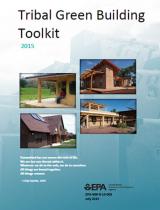Tribal Green Building Code Guidance
Tribal Green Building Ordinance, Code Language and References
This Tribal Green Building Codes guidance provides examples of tribal green building ordinance and code language as well as code references. More detailed information on Tribal Green Building, including prioritization checklists and code resources, is available in EPA's Tribal Green Building Toolkit.
- Tribal Green Building Codes
- Code Contents
- Adopting Tribal Codes
- Building Codes (Codes, Standards, Ratings, Labeling)
- State, Tribal and Local Green Building Codes
Tribal Green Building Codes
Tribes, as sovereign nations, have broad opportunities to redefine the purpose, scope, goals, and design of their systems to guide and manage construction on tribal lands.
Where no building codes are in force, tribes may have reduced control, or be subject to the application of codes that do not support sustainable and healthy building practices.
- Health and safety
- Environment
- Tribal Culture and Community Development
- Tribal Sovereignty/Self-Sufficiency
- Economic
Compared to historical tribal green building practices, little exists today. However, opportunities exist and continue to evolve to support more sustainable tribal housing. For example, the Native American Housing Assistance and Self Determination Act (NAHASDA) passed by Congress in 1996 provides tribes the flexibility to adopt and use their own building codes in NAHASDA-funded programs.
Acknowledging the great diversity of tribes' goals for sustainable building, this guidance is a resource for tribes, wherever they are along the spectrum; from adoption or adaptation of existing building codes and standards, to fundamentally different or innovative approaches to building.
This Tribal Green Building Administrative Code Example can be used as a template for technical code selection (i.e., building, electrical, plumbing, etc.) to be adopted as a comprehensive building code.
For additional examples, the Native American Rights Fund, National Indian Law Library maintains a web-based catalog listing tribes that have adopted building codes with link to those codes.
Code Contents
What is a Building Code?
Building codes are regulations, technical provisions, and referenced standards establishing minimum requirements for the construction, alteration, maintenance and demolition of buildings.
Codes are typically enacted by ordinances or laws adopted by local, regional, state, or tribal governments. Codes are laws that outline legal requirements that must are made mandatory provisions that become enforceable when adopted by statute or ordinance.
Conventional building codes were designed to protect human health and safety primarily from physical hazards, as well as to protect property and structures from fire, weather, and seismic events.
Of the numerous model building codes available today, none were developed by or specifically for tribes, or with significant tribal involvement. As a consequence, model building codes may not meet tribes' needs or priorities. At the same time, building codes are important because they guide construction practices for green and healthy building and are often required to secure funding for construction projects.
- Prescriptive codes that define both what must be done and how it is to be accomplished, and
- Performance or outcome-based codes that describe what must be accomplished but leave the "how" up to those designing and submitting plans for approval.
Most of the existing codes in the U.S. are prescriptive, though some also have performance criteria included.
Green Building Codes
Green building practices protect the natural environment, address health concerns related to indoor environmental quality, the toxicity of materials throughout their life cycle, reducing waste, and conserving energy, water, and other resources.
Over the past few decades, increasing awareness and evidence about the significant impacts related to the built environment gave rise to the "green" building movement. As green building practices, programs, and rating systems were adopted, building codes and standards needed to address these issues.
California was the first state in the U.S. to incorporate green building requirements into their statewide building code with the adoption of a set of building provisions called CALGreen. They began the adoption process by instituting the model code on a voluntary basis; however, by 2011 many green provisions became mandatory for all buildings in the State -- except tribal and federal building activities.
The American Society of Heating, Refrigerating and Air-Conditioning Engineers (ASHRAE) publishes the Standard for the Design of High-Performance Green Buildings Except Low-Rise Residential Buildings (ASHRAE 189.1). This publication, is intended to serve as a model building code on a national basis.
In 2012, the International Code Council developed the International Green Construction Code (IgCC). Like ASHRAE 189.1, IgCC contains provisions for improving the environmental and health performance of commercial and high-rise residential construction.
The U.S. Department of Energy's Going Beyond Codes: A Guide for Creating Effective Green Building Programs for Energy Efficient and Sustainable Communities (PDF) (124 pp, 3.28M) provides an overview of green codes, rating systems, and other standards.
Tribal Green Building Codes
Tribal green building codes are, first and foremost, defined by the Tribe. One way to think of building codes is as an evolving progression from conventional codes that address the physical safety of people, to green codes, that also incorporate concerns about human and ecological health and resource conservation.
To learn more about tribal green building practices and codes, download EPA's Tribal Green Building Toolkit.
Building Code Contents
- Fire safety
- Mechanical systems
- Plumbing systems
- Energy conservation
- Fuel gas
- Private sewage disposal systems
- Existing buildings
- Wildland-urban interface
Within these various codes, provisions cover these and other topics:
- Siting
- Structural integrity
- Fire safety
- Emergency exiting
- Materials
- Lighting
- Heating
- Cooling and ventilation systems
- Electrical systems
- Plumbing and sanitation facilities
- Utility connections
- Radon
- Aesthetic suitability
More recently, code provisions have begun to include:
- Conservation measures for energy, water and materials
- Indoor air quality and toxicity of materials
- Social and cultural suitability
Adopting Tribal Codes
Developing and maintaining building codes requires a tremendous investment of time, effort, and expertise. Because of this, referencing existing green building codes and standards can be very helpful.
Though many codes and standards may not fully address tribal priorities, they contain useful technical information and experience. Where appropriate, tribes can use, partially or completely, existing codes and standards to meet their priorities. Tribes may also develop an entirely new tribal code or system.
Adopting Existing Codes
The most common and least demanding approach to putting codes in place is to adopt model building codes. Governments adopting model codes consider which codes to adopt, as well as any related appendix chapters and referenced standards. It is also important to consider local climatic and geographic design criteria, including historical temperature and weather data such as:
- Frost depth
- Wind and snow loads
- Flood risks
- Local conditions (seismic risk factors, termite intensity, radon risk, etc.)
Amendments to model codes can be made to incorporate the goals and concerns important to the adopting tribe.
A consideration in adopting codes is that model building codes are usually sets of code and standard documents covering different building types (residential, commercial), and different aspects and building systems (fire, structure and general safety provisions, plumbing, mechanical, electrical, energy conservation, and now, green building). This can have cost implications since, for example, purchasing model codes and standards can be expensive. When adopting model codes, most jurisdictions only adopt the model codes that are relevant to their needs.
Because model codes can be complex, it is important to consider the relationship between different codes, or different editions of the same sets of model codes, to avoid contradictory or inconsistent requirements. To avoid these issues, a common practice is to adopt model codes in sets (usually of the same edition/year) rather than choosing codes developed by different organizations.
Many factors influence which codes to adopt. A key factor is the desire to have building codes reasonably match those of the surrounding region to ensure that experienced designers and contractors are available to design and build to the code.
Where building codes have not been adopted, the process usually requires creating a building department or some other governance structure responsible for interpreting and enforcing codes and establishing financial support for these activities. Fees for permits, plan review and inspection procedures, and other services provided should be developed. The International Code Council's code adoption resources includes information about the process of adopting building codes.
Finally, this process involves much more than adopting a set of codes. The capacity to properly interpret and enforce the codes is critical. Even the best codes, if not enforced properly, cannot provide the intended protection and benefits.
Example: Kayenta Township, Navajo Nation
The Kayenta Township, in the Navajo Nation, went through the whole process: establishing a building department, developing a code adoption and enforcement process, and hiring staff to carry out the work of permitting, inspection and code enforcement.
In that process the Township adopted the Kayenta Township Building Codes, including many of the ICC model codes, including an early version of the International Green Construction Code (IgCC). Among the many considerations that the Township used for their decision to adopt the 2006 editions of the International codes, was that the 2009 codes required residential fire sprinklers, which they did not think were appropriate for many new homes within the jurisdiction. The Kayenta Building Official describes the process they went through in a presentation: Kayenta Township Building & Safety Department, Tribal Green Building Code Summit Presentation. A brief outline of this process is below.
Conduct Initial Research
- What building codes or standards have been applied in the region?
- What type of construction is driving the market (Commercial or Residential)?
- What standards are professional registrants of record referencing?
- What codes or standards were used in the construction of buildings in the community?
- Are insurance carriers insuring properties in the community?
Identify Other Authorities Having Jurisdiction Over Land and Have Adopted Building Codes
- Tribe
- State
- County/Municipality
- Utility
Request for Assistance from Local Jurisdiction for Building Code Adoption
- Maintain consistency in the region
- Establish great partnerships up-front
- Identify and address obstacles that exist
- Possibly share resources
- Why re-invent the wheel?
Procedures for Adopting Tribal Code/Ordinance (will vary by tribe)
- Organization and Format of Code Notice and Reading Requirements
- Public Participation; Written Statements
- Process for Enacting/Adopting an Ordinance or Rule
- Effective Date of Ordinances and Rules
Develop Code Implementation and Enforcement Authority
- Build tribal code expertise (training, staffing)
- Coordinate with external inspectors (local, state, contractors)
Adapting or Amending Existing Codes
Some tribes adapt or amend building codes to assert cultural sovereignty, address tribal priorities, and build tribal capacity.
In the process of adopting building codes, it is common for the adopting government to make changes to them by deleting or adding parts or changing specific provisions. This is typically done to address specific local concerns, conditions, or opportunities.
Amendments also often specify which appendix chapters or other rules or policies are adopted or excluded and what specific practices are to be adopted or exempted from coverage. In general, provisions provided as appendix chapters of codes are included as optional choices.
Some code appendices can include green options. For example, the California's Green Building Code (CALGreen) residential and non-residential voluntary green measures are included in the code as two appendix chapters. Appendix chapters can also include things like gray water reuse, rainwater harvesting, or interface measures with land use plans, such as assuring solar access.
A good way to find examples of code amendments is to look at state and local code adoptions. The Bulk Resource site provides free access to many state and local building codes.
Code Electives, Tiers or Options
In recent years, a new concept in building codes has been developed, often called "stretch" or "reach" codes or, in the case of California's, CALGreen Code voluntary tiers of performance, which go beyond mandatory code requirements. These higher requirements are written in mandatory code language, so that when they are chosen they can be properly reviewed and implemented. Tribes can specify the adoption of higher performance building requirements over time
CALGreen Resources provides summaries of the code’s mandatory residential provisions and the two tiers of optional measures for projects aiming to exceed the code's minimum requirements.
Other examples include the Oregon Reach CodeExit and the Massachusetts Stretch Energy Code.
Code Electives
- Conservation Area
- Agricultural Land
- Greenfield Sites
- Site Disturbance Limits on Greenfield Sites
- Stormwater Management
- Light Pollution Control
Adopting Specific Code Edition to Meet Tribal Needs
(e.g., Lack of Infrastructure for Fire Sprinklers in Homes)
Some tribes may find that an earlier edition of a model code fits their situation better than the most recent edition, and thus reduces the number of amendments needed. For example, tribes in extremely rural or remote locations may lack of infrastructure and services for fires sprinklers or other code requirements, making standard codes inappropriate or unreasonably expensive.
This was part of the reason the Kayenta Township chose the 2006 rather than 2009 editions of most of the I-Codes. In particular, the 2009 International Residential Code requires fire sprinklers in homes, which makes little sense for houses built in rural locations without water infrastructure. On the other hand, they chose the 2009 International Energy Conservation Code (IECC) because they preferred the energy code provisions in that edition to those in the 2006 IECC.
Code Amendments
Other amendments the Kayenta Township made to their codes as can be seen in the Kayenta Township Building Codes. They used asterisks (*) to indicate within the body of the code the type of amendment that has been made:
* Indicates amendment(s) have been made to section.
** Indicates new text has been added to section.
*** Indicates a new section or exception has been added.
**** Indicates a section or exception has been deleted in its entirety.
The amendment process can be a good way for tribes to introduce provisions covering their own historic or traditional designs and building methods and materials, or more generally, for regionally appropriate materials or methods not currently available in local, state, or national model codes.
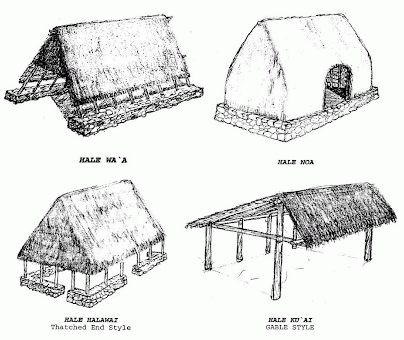 Indigenous architecture examples, Maui, HI. See the "Rules Pertaining to Indigenous Hawaiian Architecture Structures (PDF)" (36 pp, 1.7MB, About PDF) ExitTraditional Structures
Indigenous architecture examples, Maui, HI. See the "Rules Pertaining to Indigenous Hawaiian Architecture Structures (PDF)" (36 pp, 1.7MB, About PDF) ExitTraditional Structures
In Hawaii, the County of Maui has adopted codes for construction of Indigenous Hawaiian architectural structures outlined in Chapter 36 of their building code. An excerpt from Maui's code:
"This code shall be administered with due consideration given to the County policy that indigenous Hawaiian architecture furthers the County's compelling interests in cultural, environmental, and historic preservation; energy efficiency; economic development; aesthetic beauty; and public safety."
Alternate Materials, Designs and Methods of Construction
Maui County, Hawaii Code of Ordinances, Title 16.26 – Buildings and Construction – Chapter 16.26.104 amended. An excerpt from Section 104 of the Maui Uniform Building Code is below:
Section 104 of the Uniform Building Code reads:
"104.2.8 Alternate materials, alternate design and methods of construction. The provisions of this code are not intended to prevent the use of any material, alternate design or method of construction not specifically prescribed by this code, including elements based on or inspired by principles of indigenous architecture, such as those associated with structures comprised of either rock walls or wood frames for the bottom portion of structures and thatch of different native grasses and leaves for the roof, provided any alternate has been approved and its use authorized by the building official…
…The following material are examples of the types of material that may be considered by the building official, if used for the construction or renovation of a structure that is based on or inspired by principles of indigenous architecture: Wood for house timbers (walls): hamau, kauila, lama, nioi, and 'ohi'a; and House thatch and lining material (roof): lala 'ama'u (fern fronds), lauhulu and lau mai'a (banana leaves)..."
Adopting Code Flexibility to Support Living Building Challenge (LBC)
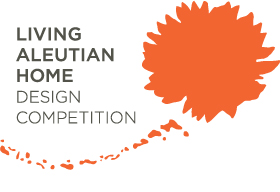 The organization which has developed the LBC, the International Living Future Institute Exit sponsored an affordable housing Living Building Challenge competition, the Living Aleutian Home Design Competition, in cooperation with the Aleutian Housing Authority in Alaska.The Living Building Challenge (LBC) is a certification program designed to encourage built projects which go beyond minimizing harm to create projects that are beneficial across the spectrum of their impacts. The LBC is an emerging standard for restorative and regenerative building projects, going far beyond the minimum requirements of even the most advanced green building and land use codes.
The organization which has developed the LBC, the International Living Future Institute Exit sponsored an affordable housing Living Building Challenge competition, the Living Aleutian Home Design Competition, in cooperation with the Aleutian Housing Authority in Alaska.The Living Building Challenge (LBC) is a certification program designed to encourage built projects which go beyond minimizing harm to create projects that are beneficial across the spectrum of their impacts. The LBC is an emerging standard for restorative and regenerative building projects, going far beyond the minimum requirements of even the most advanced green building and land use codes.
Seattle, Washington has developed a pilot that gives their land use and building departments greater flexibility in enforcing codes to enable and encourage these high performance projects to be built. This approach also can apply to creating and adopting tribal codes and systems.
Amending Codes to Remove Barriers
Organizations that create building codes typically recommend that their codes be adopted without amendments. Yet, the needs of each jurisdiction and community are different. It can be helpful to research how similar communities have created their amendments.
- Limited Rural Access to Facilities for Building Materials Recycling
Kayenta Township on the Navajo Nation determined that due to their rural location and limited building materials recycling markets that they could not currently meet the minimum 50% Construction and Demolition Debris Recycling option in the IGCC Table 302.1, Section 502.1, so they adopted it with this amended language: Minimum percentage of waste material diverted from landfills — 20%. - Increased Kitchen Ventilation
Some tribes may face housing overcrowding that leads to cooking for large numbers of people on a continuous basis. To reduce poor indoor air quality and mold associated with cooking, building codes can be amended to increase kitchen ventilation requirements. For some tribes, using outdoor kitchens has been a practical solution for avoiding indoor air quality issues caused by indoor cooking. Building codes can be amended to include outdoor kitchen facilities. - Doors Facing East
Traditional Navajo houses were built with the door facing East so they could greet the rising sun every morning. Code language could be incorporated to support this cultural priority.
Developing and Adopting Tribal Codes
Some tribes are working to develop their own building codes to assert cultural sovereignty, address tribal priorities, and build tribal capacity.
The Pinoleville Pomo Nation's citizens wanted to design homes and associated codes that are expressions of Pinoleville Pomo culture, and further tribal goals of political sovereignty and environmental protection. The Tribe created its own performance-based standards that permit the highest degree of design freedom, while also protecting health, safety and well-being of: current residents, neighbors, and future generations of people and non-humans that share local ecosystems.
Process: Developing Tribal Performance-Based Codes
- The Pinoleville Pomo Nation (PPN) participated in a co-design process developed by the University of California, Berkeley's Community Assessment of Renewable Energy and Sustainability (CARES) to design HUD-funded housing that is culturally-inspired and meets tribal goals for sustainability, environmental harmony as well as political and economic sovereignty.
- The tribe developed draft performance-based codes: Draft Pinoleville Pomo Nation Tribal Green Building Code.
The Final Design Included
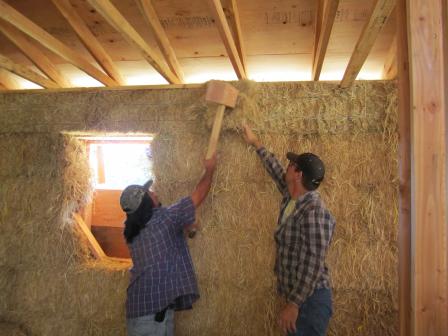 Pinoleville Pomo Nation used HUD funding to build green homes built with local straw and earthen materials and EPA GAP funding to support the development of Tribal Green Building Codes.
Pinoleville Pomo Nation used HUD funding to build green homes built with local straw and earthen materials and EPA GAP funding to support the development of Tribal Green Building Codes.- Renewable energy production and energy conservation to reduce dependence on outside service providers and to assure tribal reliance on clean energy.
- Water conserving technologies such as grey water and rainwater catchment systems to reduce vulnerability to water shortages and support the on-site production of gardens.
- Green/healthy local building materials such as straw bale, earthen plaster, non-toxic paints to address priority health problems among tribal citizens associated with housing.
- Social sustainability strategies including the training of tribal labor, local-sourcing of materials, employing technologies that allow for local maintenance and upkeep, and building strategies that re-enforce tribal community bonds through shared labor, shared involvement in design, and community pride in housing, and the creation of spaces for gatherings, including large kitchens and outdoor areas.
- Cultural elements such as rounded walls, east facing windows, spaces for prayer and reflection, and spaces for practicing traditional tribal arts.
Process Overview
- Identify community goals and values
- Co-design
- Develop a code template
- Technical partner review
- Create a library of documents
- Develop Tribal Code Review Panel system
The Pinoleville Pomo Nation Process
- After the initial design was completed, the PPN sought technical experts who supported the co-design process, and respected tribal desires. This was especially important because during the building phase, modifications to the design were necessary to deal with budget and technical barriers
- Once a final design was settled on, they developed a tribal code template to lay out the key tribal goals for construction and the underlying values. The template includes performance standards that should be met, but allows designers and builders (including tribal citizens) to be creative in how those standards are met. PPN had law students review the template and include language that improves accountability of designers and builders, but maintains a large degree of creative freedom.
- Engaged technical partners again to figure out what resources and references, including existing codes, could be used to support the construction project.
- Accumulated resources and created a library of "code-relevant" documents.
- Planned to develop a Code Review Panel system at the tribal, regional, and national levels to address specific code issues. The Review Panel plan proposed to include citizens who can keep tribal values "front and center" in the review process, and technical green building experts to identify potential problems with the design and construction of the buildings, evaluate the final product, and monitor the building's ongoing performance.
Building Codes (Codes, Standards, Ratings, Labeling)
- Overview of Code Development Organizations
- Green Building Labeling Systems, Codes and Standards
- Tribal Buildings Certified Under Rating Systems
- Tribal LEED Projects
- Green Globes®
Overview of Code Development Organizations
In the U.S., model building codes are developed by organizations whose main membership typically includes the governmental officials responsible for enforcing related areas of codes and regulations. They generally use a comment-driven development process open to interested parties, including tribes. These include buildings, fire and electrical systems, and plumbing and mechanical systems.
The U.S. does not have official national building codes developed through a federal or national process and adopted uniformly nationwide. Instead, there are recognized organizations that develop codes and standards that are adopted by state or local (municipal or county) governments, as well as by tribes, who may also modify model codes to meet their specific needs.
The codes and standards gain their enforcement authority through the state and local government adoption processes. Because of this, there is little uniformity across the country and states and local governments are able to modify the codes they adopt. Some states and a few cities have their own codes. For tribes, this provides more options from which to choose appropriate code language.
Green Building Labeling Systems, Codes, and Standards
For information on Tribal Green Building as well as labeling systems, standards, codes, and tribal case studies, download EPA's Tribal Green Building Toolkit.
EPA also has information on a variety of Green Building Standards, Codes, and Rating Systems.
Tribal Buildings Certified Under Rating Systems
Rating systems are usually voluntary industry technical guidelines for how to construct, renovated, or operate a building.
Leadership in Energy and Environmental Design (LEED) Rating System
Developed by the U.S. Green Building Council, LEED certification provides independent, third-party verification that a building, home or community was designed and built using strategies aimed at achieving high performance in key areas of human and environmental health: sustainable site development, water savings, energy efficiency, materials selection and indoor environmental quality.
Tribal LEED Projects
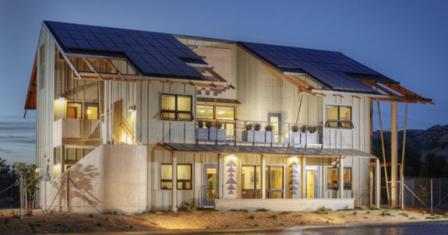 Yocha Dehe Wintun Nation LEED Platinum Maintenance and Operations Building in California.Example of Tribal green building rating system certified projects include:
Yocha Dehe Wintun Nation LEED Platinum Maintenance and Operations Building in California.Example of Tribal green building rating system certified projects include:- Yocha Dehe Wintun Nation Maintenance and Operations Building in California (PDF)
- Puyallap Longhouse in Washington
- Coeur d'Alene Tribe Resort Expansion in Idaho
Green Globes®
Developed by the Green Building Institute, Green Globes® is a green building guidance and assessment program that offers an effective, practical and affordable way to advance the overall environmental performance and sustainability of commercial buildings.
Tribal Green Globes® Projects
State, Tribal and Local Green Building Codes
Over 275 cities, counties, and states have created building codes or building programs to increase the environmental and health performance of their communities. Examples of these codes and programs, that can be adopted or adapted by tribes, are covered in the Tribal Green Building Toolkit.

